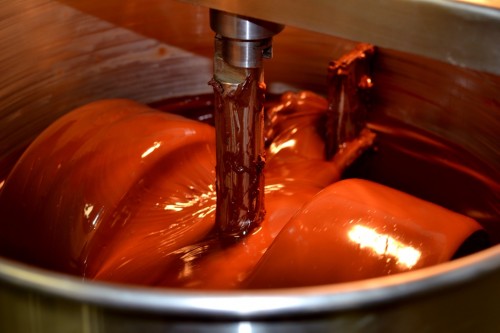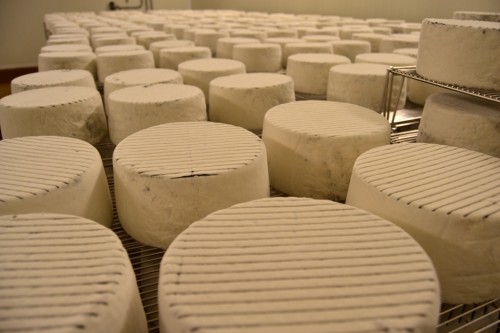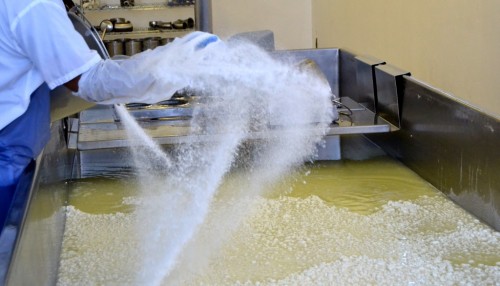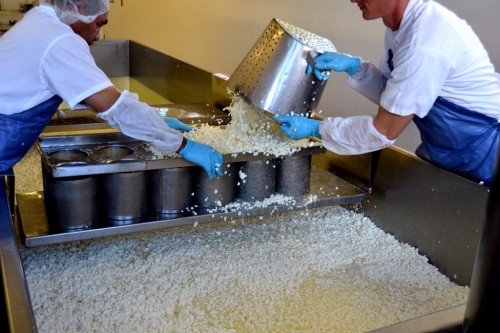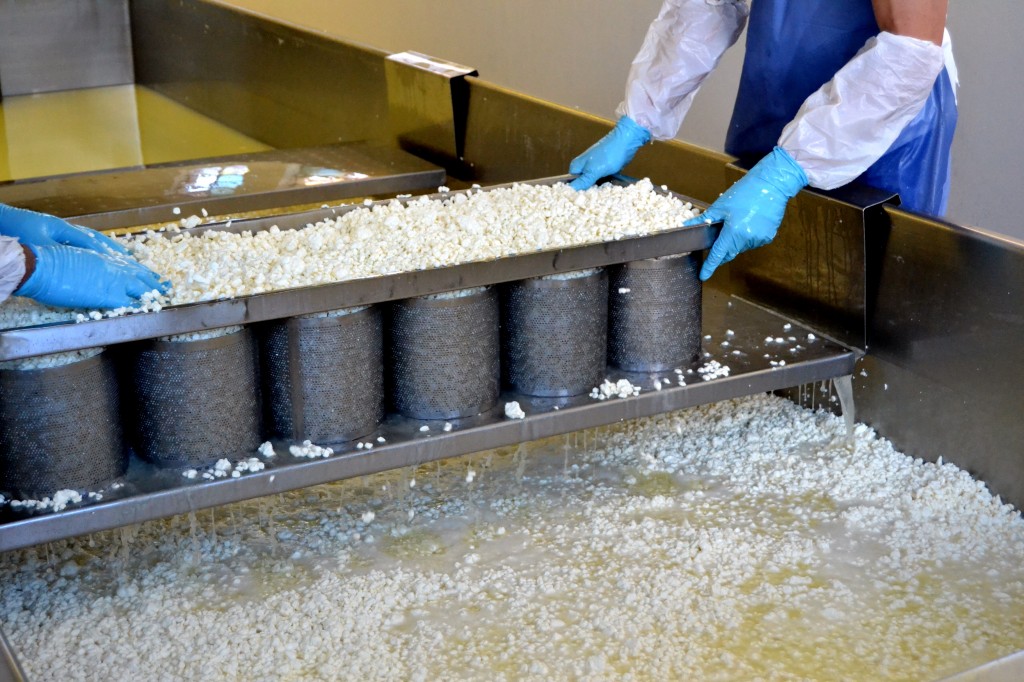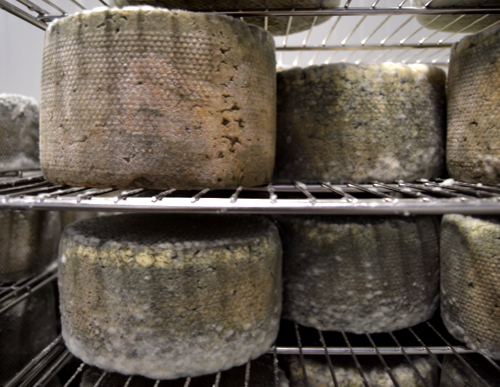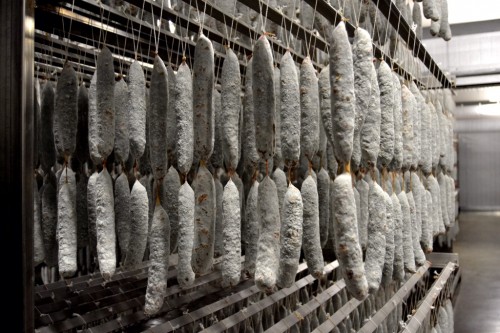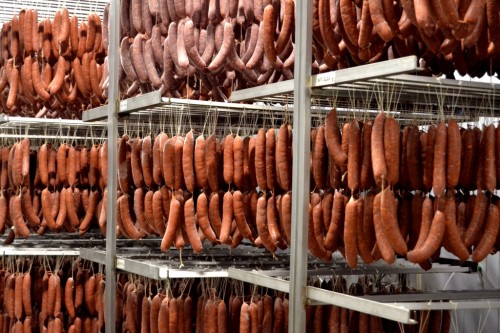Road Trippin’ – A Summer Food Tour Chronicle
This summer I travelled up the Northern California coast on a journey to visit a handful of food artisans ending ultimately in Portland, Oregon. My 5-day, 900-mile journey took me up to Humboldt County to visit Dick Taylor Chocolate and Cypress Grove Chevre, crossing across the Jedediah Smith Redwood forest into Southern Oregon to spend a day at Rogue Creamery, then jetting up to Portland to join my wife for the weekend and visiting Olympia Provisions and Ancient Heritage Dairy.
My first stop was Dick Taylor Chocolate in Eureka. Partners Dustin Taylor and Adam Dick founded their bean to bar chocolate company 5 years ago from a bag of cocoa beans purchased online out of personal curiosity into an award winning craft chocolate business. After my drive up from The City the shop had closed for the day but there was a little activity behind the scenes still going on. I was met by Dustin Taylor and his toddler daughter for a tour around the facility. Chocolate factories are awesome and my one of my favorite impressions is the wonderful aroma, as if there is a never-ending batch of brownies in the oven. I guess if you work there every day you might not notice it as much, but for me its heavenly!
Being former boat builders and construction workers, these guys like to do it all by hand, and Dustin showed me around the warehouse outfitted with reclaimed wood and hot-rodded equipment. I was particularly impressed with the very low-tech method they employ to cool their chocolate bars by attaching very small window air conditioners to a steel rack that’s enrobed in a food grade plastic curtain.
Chocolate making is pretty straight forward, and at Dick Taylor it’s strictly 2 ingredients – cocoa beans and organic cane sugar. The beans are sorted to remove any rocks, twigs, or other debris then roasted in a very small 30lb drum coffee roaster. From there the beans are cracked, winnowed, and sifted to remove the outer husks and skin, then crushed in a mill with sugar to a fine paste. This paste, or cocoa liquor, is sweetened to a uniform 50% at Dick Taylor to create a base in which additional unsweetened cocoa liquor is added to their profiles of 71% or darker.
The XX% you see on a chocolate bar is the amount of cocoa, with the remaining percentage comprising sugar, perhaps vanilla or other flavoring, and cocoa butter or other emulsifiers – the higher the number, the darker (or less sweet) the chocolate. To create a smooth fine texture, the warm chocolate is further ground and aerated in a process known as conching. 2 stone wheels, 1 horizontal like a vinyl record turntable and another vertical, rotate in harmony to smash the sugar and cocoa into smaller and smaller particles while exposing the chocolate to air (oxidizing) to bring out nuance and complexity in the aroma and flavor. Once ready the warm liquid chocolate is tempered to the proper temperature to assure a good crisp texture, then poured into plastic molds and slowly cooled.
At Dick Taylor they do all the wrapping by hand, first in foil to protect from light and air, then in paper using letter-pressed paper they produce themselves at another facility. Dick Taylor has launched a limited release Bolivian single origin bar now available at The Plus along with our favorite Belize and Fleur de Sel bars.
Inside Dick Taylor Craft Chocolate
The next morning I visited Cypress Grove Chevre in the neighboring town of Arcata. Founder Mary Kheen began making fresh chevre and yogurt for her family and neighbors more than 30 years ago, and has steadily expanded her business from a regional producer to a national powerhouse. She is a farmstead producer, although her goats are a few miles up the mountains from the cheesemaking facility. The farm is a 36 acre American Certified Humane Model Dairy. Her most famous cheese is Humboldt Fog which she debuted in 2004, turning the international cheese community on its head as no American chevre could ever rival nor surpass the French – but she did it, all behind the Redwood Curtain in Humboldt County.
My tour guide through the cheese plant was Cody, a senior team member at the creamery who is responsible for quality control. After being suited up with a hairnet, beard snood, rubber booties and a lab coat, we walked through a sanitizing liquid footbath to assure no improper contaminants were being introduced into the cheesemaking facility. Once inside he showed me the various tanks used to create the curd for the chevre. This involves a 3-day process of gently warming the milk, adding the cheese culture, and slowly fermenting the milk until the curd separates from the curd, ultimately resulting in cheese. These tanks are huge, and frankly I was a little claustrophobic peering inside, knowing that someone has to get in there and scrub them clean after the cheese is removed.
Once the curd has been removed it is placed into large muslin bags (giant pillow cases) and hung to facilitate draining. Once drained the curd goes to its final production room – either to be made into fresh cheese, or for aged cheese like Humboldt Fog or Truffle Tremor. At the final stage the cheese is salted, seasoned if a flavored cheese, and formed into its final shape or format. Cody took be see the Humboldt Fog being made. This room was slick with black liquid on the floors and equipment. This black liquid is charcoal, or edible vegetable ash, mixed with a little purified water and is used to produce Humboldt Fog’s unmistakable look and flavor.
Humboldt Fog production at Cypress Grove Chevre in Arcata, California
Ash is a very traditional ingredient in cheesemaking, dating back many centuries when cheesemaking was done over an open fire. Cheesemakers would simply gather the ash from the side of the pot used to make the cheese and rub it on the face of the cheese to preserve the cheese and protect it from flies and other critters. An added benefit is how the ash can alter the acidity of cheese, mellowing the harshness that many often associate with goat cheese. A few years ago they applied the ash in powder form, but now find it more beneficial to the cheese and the staff to spray it on. I was surprised to see the wheels were really muscled into shape by hand. I assumed this was more mechanically done in a machine, but to assure even texture it needs a human touch… er punch! Once formed and coated in ash, the wheels are placed on racks and put into cold storage to age. In the aging room you could see that in just a couple days time a soft pillowy white mold was forming, and those wheels made a couple of weeks ago were almost snow white with just a hint of the grey ash beneath the surface.
Mary took me out to see the goats at the farm. Along the way we talked about the industry and reminisced on the 20 years we’ve known each other and how fast things seem to change in the world. But at the farm, despite its modern energy efficient barn design and computerized record keeping, its strictly natural old school methods of nurturing care for the goats and the land. We met a few newborn goats struggling to stay up right, and their older cousins – cute, precocious, and oh so happy to give a kiss or nibble if you’re not paying attention. After a late lunch with Mary on the square in Arcata, I was off to my next stop, up the coast and across the mountains into Oregon and Rogue Creamery near Grant’s Pass.
The next morning I rose early, I was excited to head down to the Rogue Creamery in Central Point where I had persuaded the team to let me take part in the cheesemaking today. I’ve been to many a cheese plant, and aside from pulling some Mozzarella with John Loomis at Zingerman’s Creamery in Ann Arbor, I’ve never had the chance to get my hands in the vat. Truth be told, I’m not so sure it was their intention to let me get in, but I guess my repeated email inquiries could not be ignored. My guide for the day was Jason, a hard working local guy who told me a little about his history with the company and how there were few choices to start a career in this rural area 15 years ago aside from the logging industry. He found his way to Rogue a few years back and has excelled there to become a cheesemaker and backbone of the operation. Jason let me know the ground rules – no photos here, don’t touch that; answering my early questions with “that’s proprietary, can’t tell you more”, but soon loosened up when he realized I was as excited about the cheese as he is.
Rogue makes Blue and Cheddar cheese, and each need to be made in separate facilities so no cross contamination occurs. Our tour started in the Cheddar area and they were just finishing production and cleaning the room. A tour of the aging rooms revealed many styles of Blue cheese at different ages. Again, like at Cypress Grove, the young cheeses had a few whiskers of mold, grey/green this time, while the older cheese was really moldy. These are hand made products and you can see impressions of thumbprints on the exterior as these cheeses need to be turned regularly to resist moisture from building on the bottom of the cheese.
Rogue is an established cheese plant, built many decades ago with well-aged cinder block construction. Through modernization, Rogue has replaced a few of the old walls with modern smooth fabricated walls, but still leave a few old bricks intact to keep the original cheese cultures alive – similar to wild yeasts in wine or bread making. Like most cheese plants, each aging room has it’s own unique temperature and humidity needed for the style of cheese it contains. I was surprised how fresh the air smelled in the blue aging coolers. Jason pointed to a giant white air sock they installed which keeps great air circulation without the usual blowing wind of conventional fans. I’d say it was money well spent, as the cheese doesn’t suffocate on its own gas in that environment.
Now we’re ready to go to the make room and “do the dip”, referring to dipping into the vat of curds to form the cheese. Because I had been carrying my camera around I needed to change into a second set of clean clothes, before getting aproned up, scrubbed down, and ready to go. A couple of hours earlier the milk was added to the vat, brought to temperature, cultured and renneted. The curds had been gently stirred as the team waited for the pH to get where they want it. We waited a few minutes and the fellas where relaxed and jovial, but as they watched the pH readings, you could feel the tension building – the boys were getting their game faces on. They told me when they say go, we have about 15 minutes to get all the curd out of the vat and into the molds – and it’s a big vat about the length and shape of 2 pool tables The cheese is scooped using a big stainless pail, and spilled into a row of perforated molds that rest atop a flat stainless steel plank stretching across the top of the vat.
3, 2, 1 and we’re off, the drain is opened and the whey is pumped from the vat, and the curds are quickly scooped up. The fellas did a few rounds themselves, then let me jump in. As I leaned over the vat, I could feel the blood pumping in my head. I dragged a big scoopful of curds, and it felt like a million pounds. My back barked at me, but I wanted to do this thing, so I scooped again, and again, and again. Once we finished a couple racks I moved out the way and help push the stray curds to the bottom of the vat as the other guys scooped up the last of the batch – I think we made about 8 dozen wheels in those 15, maybe 18, minutes. Cheese make rooms are hot and humid, and we were all drenched, red faced, but satisfied. The wheels were left to drain for a few hours, and later that afternoon, they were turned and taken to cold storage. This process is repeated daily, 365 days a year, and during peak season multiple times a day – hard work indeed.
After a quick tour of the retail shop and a great lunch of grilled cheese sandwiches with Rogue’s retail shop manager, Tom, I was off to see their dairy farm outside Grant’s Pass. The farm is a new endeavor for the Rogue team. They’ve investing in a modern automatic milking system for their cattle, which monitors the production levels of the cows for optimum health rather than optimum output. It’s an ingenious system where the cows head to the milking area when they are ready to be milked 24 hours a day; which I learned is better than forcing into the traditional twice a day only cycle. In the machine, when the output drops the cows are released back to the grass, and can come back for milking when they’re ready again.
Todd, the farm manager, showed me around a bit in between his busy chore schedule, explaining their philosophy of animal management, and explaining how their canvas-skinned barn was natural cooler and allows more daylight than old-fashioned wooden barns. We wrapped up at his house where I met his family – a couple of the sweetest Welsh Corgis who immediately rolled onto their backs for me; a stout yet friendly snorting pot bellied pig; baby goats; and a another very tired pig who was milking her just-birthed babies.
As I pulled away from the farm I realize my heart was warm and I had the biggest smile on my face. These Rogue folks got a good thing going on – they’re serious and committed to having a positive impact on the world, yet soft spoken and relaxed at the same time, a killer combination. It’s been a great day and I’m off to Portland now after a quick (3 + hour round trip) detour up to Crater Lake. I highly recommend a trip to Crater Lake if you get the chance. Tune your car radio to KRRM 94.7 and enjoy the ride!
I made my way to Portland for a few hours sleep before heading to the eastside to visit Elias at Olympic Provisions the next morning. Olympic makes great salami and cured meats, and has recently moved into a new productions facility a couple of blocks from their restaurant of the same name. Olympic, now renamed after Olympia to not be confused with the international games, is a family affair with Elias’ sister Michelle as a business partner, their mother doing product demonstrations and working the farmers market, along with cousins and nieces much like the characters in My Big Fat Greek Weeding. Niece Alexis was my guide for the tour, taking a break from her sales position to suit up and take me through their expansive plant. Similar to the aromas at chocolate factories, their place evoked a pot roast that had been cooking all day, filing the house with delicious aromas.
On this day there was no dramatic production to see. I had envisioned walking into a giant smoker, enveloping my self in the sweet elixer, but they did that yesterday and the meats were now being packaged and shipped out. But I was able to see the hand butchering – meticulous and clean cuts by a cadre of fellas with big knives. In another production room a trio of jovial guys were trimming thyme leaves by hand, peeling garlic cloves, and measuring spice blends. Alexis took me through their aging coolers, and I was amazed how big the salami sausages are when they are made. After a few weeks of aging they shrink exponentially as they lose their moisture and transform into flavor packed bundles of joy. Much like cheese, mold growth advances as the sausages age, completely covering the casings over time.
Elias (Eli) came out to meet us, and explained to me the method he employs to make his salami and cured meats. He prefers a lower acidity salami, not as tangy as we have here in San Francisco, which showcases his unique seasonings, many evoking his Greek heritage. Eli studied cooking in Europe, when he came back to Portland, he realized how much he missed the variety of great salami and cured meats, and set out to be Oregon’s first USDA salami facility. We walked a couple of blocks down to his restaurant and he showed me inside his original USDA meat facility within the restaurant, now a storage room, but really little more than a closet and a cooler.
Eli and his family are busy folk, with 2 restaurants and a production/distribution center to manage. So he was off to another meeting. I stayed for a quick lunch at the counter and feasted on his fine sausages, salami, and cured meats – wonderful!
I had one more stop to make on my producer tour, and impromptu drop-in at Ancient Heritage, an urban creamery just a couple of blocks away from Olympic (thanks Eli for the tip!). Unsure if I’d be able to see anyone or any production I casually knocked on the door and walked inside. They were in the middle of production of 2 cheeses, and with a quick greeting they told me to suit up, sanitize, and join them. Owner, Paul Obringer, and his assistant had just prepared a number of small format Adelle, and were waiting for a batch of Heritage to reach the proper pH for scooping into molds. Ancient Heritage is a small glass lined dairy smack in the middle of an industrial/restaurant neighborhood. Ancient Heritage produces a wide range of cheese from sheep and cow milks they source from nearby farms.
While the small cheeses were draining and the next cheese was setting up, Paul took me through their aging coolers to show me the line up of cheese. In the corner of the cooler I saw what looked like a pile of sawdust under a rack of cheese. “They’re helping me win the culture war in this new cooler, he said. They were cheese mites, a natural occurrence in many cheese facilities, and one he welcomed to help keep errant cheese cultures from taking over his pristine new cooler – much like Rogue’s old walls well-seasoned with beneficial cheese culture. We tasted a few cheeses, and headed make to the make room – the show was about to start! The production today was much smaller than yesterday at Rogue, 18 cheeses, so the pace was quite laid back comparatively. Once the cheeses were in there plastic molds, they were turned once and in a matter of a minute or so had drained so much liquid they were almost half the volume and taking on a nice shape. The wheels were given a small production sticker with the date and number, then stacked in their forms in a vertical press, one on top of the other, and allowed to drain under natural pressure. Periodically the bottom wheels are moved to the top so that it doesn’t get too squished from all the pressure. After a few hours, the cheese is sent to the cooler to age. For the crew at Ancient Heritage, though, it was time for a late lunch – they had been making cheese all day, and needed to fuel up before a few hours of clean up.
Cheesemaking at Ancient Heritage Dairy in Portland
It had been a few years since my last visit to Portland and a friend there took me out to see all the trendy food spots along Division Street – thanks, Maura! The downtown farmers market on Saturday was a blast, with great prepared food vendors alongside fantastic produce. Portland’s cheese kingpin, Steve Jones, recently opened Chizu, his sushi bar-inspired cheese restaurant, and I had a blast tasting through a number of Pacific Northwest cheeses I was unfamiliar with.
In the end, I visited 5 of our vendor partners, tracked 900 miles in my rental car, and had the time of my life doing so. Thanks to the kind generosity of my hosts who put me up in fabulous digs and allowing me to spend a little time behind the scenes to learn more about their world class food businesses!
-Ray


